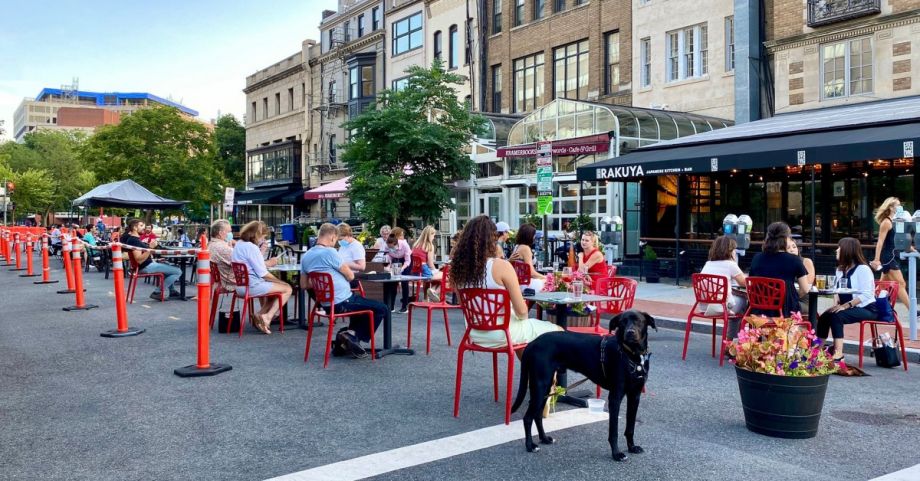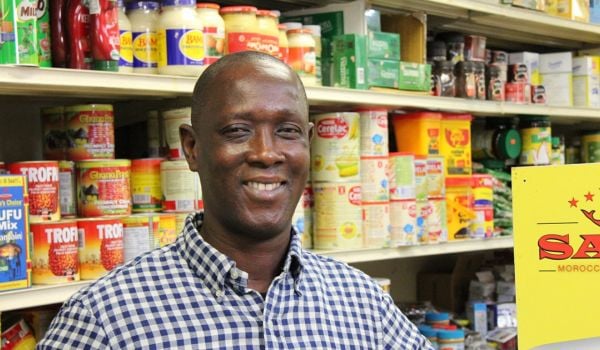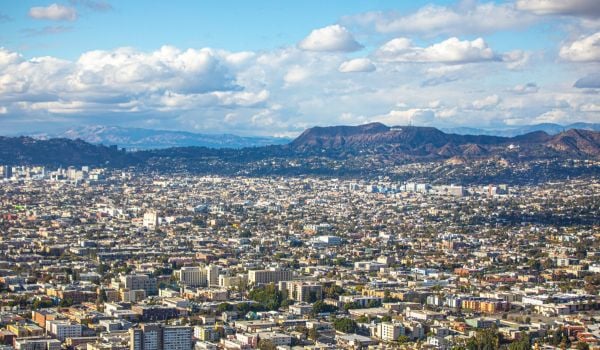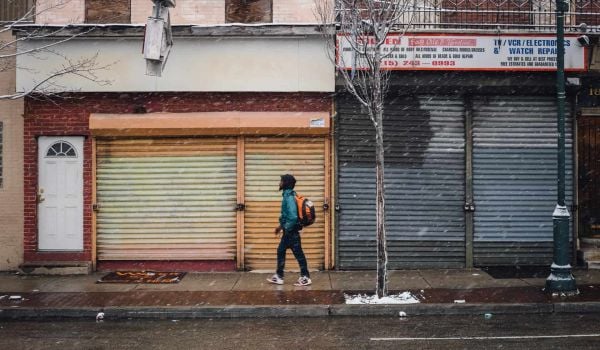Welcome to “The Mobile City,” our weekly roundup of newsworthy transportation developments.
The economy wasn’t the only thing that fell off a cliff when governors around the country put their states on lockdown in order to flatten the COVID-19 infection curves. Driving also nosedived. But while both the economy and driving have picked up since then, the coronavirus put a driving trend already underway on fast-forward. As the shift from office work to work from home bids to become permanent, so driving will also return to a “new normal” well below the level of the old normal.
This won’t spell the end of cars: The continued growth of autocentric suburbs makes that impossible. But it will mean fewer cars on the streets and more of them parked at home most of the time. This, in turn, means cities now find themselves with road space on their hands, and many of them are moving to reclaim it for other uses. This week, we offer some examples of reclamation projects that are likely to have staying power.
We also have an update on the effort to provide relief to struggling transit agencies as part of a second round of coronavirus stimulus, and it’s not good news.
The New Normal: Less Driving + More Deliveries = Fewer Cars on the Road
Have we indeed reached peak car? Yes, says Bloomberg columnist Justin Fox.
His Oct. 5 Bloomberg Businessweek essay notes that even before the COVID shutdowns, vehicle miles traveled (VMT) were on the decline as growing numbers of office and professional workers did more of their work from home — and more of their shopping as well. The shutdowns, however, suddenly swelled the ranks of the work-from-home crowd and drove many more shoppers away from driving to the store. And while having goods delivered has caused delivery vehicle miles traveled to rise, the overall effect is a significant net reduction in vehicle miles traveled. (Think about it for a minute: one delivery truck making stops at 20 addresses will mean fewer VMT than each of those 20 households driving to various shopping destinations.)
And, Fox says, even though VMT will creep back up as some of those home-based workers return to the office, it will not only not return to the levels of the mid-2000s, when VMT in the United States peaked, but it will also level off below the lower pre-COVID-19 peak. Fox cites a KPMG study that estimates that VMT per capita will plateau at 90 percent of pre-2020 levels. And those levels are themselves five percent lower than they were when VMT peaked in mid-2006.
Those former drivers are already enjoying a huge time dividend: A University of Chicago study cited in the essay notes that Americans working from home are saving 60 million hours of commuting time.
So if there’s all this road space being used by fewer cars, is there anything else we can use it for? Read on.
Minneapolis Puts Major Thoroughfare on a Road Diet
One very logical use for that freed-up road space: Devote it to healthier and more efficient ways of getting around.
Transportation planners in Minneapolis intend to do just that with Hennepin Avenue, a major thoroughfare that heads southwest from downtown.
The Southwest Journal in Minneapolis reports that the city intends to completely rebuild a 1.8-mile stretch of Hennepin just to the south of Lowry Hill in 2023. The stretch in question, from Franklin Avenue south to Lake Street, was last rebuilt in 1957, and city project planner Becca Hughes told the paper that the street is congested and doesn’t work well for anyone.
The proposed redesign will make it work better for bicycle users and Metro Transit riders, make pedestrians safer than they are now, and may even improve the flow of cars even with fewer lanes devoted to them.
The six designs presented at a Sept. 22 open house all conform to a city policy that upends the old hierarchy of uses by putting pedestrians first, then bicyclists, then transit riders, then cars. All of the designs would reduce car travel lanes to one in each direction, down from the current two, and all but two of them would eliminate on-street parking; the two that do not cut the amount in half. Four of the six call for protected bike lanes and dedicated bus lanes in each direction.
The ultimate goals of the redesign is to make the street safer for all who use it and easier for the modes that move the most people to travel along it. In the Uptown neighborhood of southwest Minneapolis, just south of the redesigned stretch, anywhere from 770 to 3,400 people walk along it, 200 to 280 bicyclists ride down it, 6,400 riders take 400 buses up and down it, and 15,000 to to 31,500 cars and trucks traverse it daily. At peak hours, the buses account for only three percent of vehicles on the street but carry 47 percent of the people using it to get to and from work. In addition, pedestrians account for the majority of serious injuries resulting from crashes on the street even though they are involved in only 19 percent of the crashes. Hennepin Avenue in Uptown was rebuilt in 2018; that rebuild cut on-street parking in half and introduced a dedicated bike lane in one direction.
Philadelphia Turns Parking Spaces into Restaurants; Residents Welcome the Change
One common conversion that has happened in large cities is the planting of dining tables in the curbside spaces where cars once parked. Many cities have adopted this strategy as a way to keep their restaurants in business in the face of post-COVID-lockdown capacity restrictions.
One might expect that in a city like Philadelphia, which gave TV viewers several entertaining seasons of “Parking Wars” and where residents in some neighborhoods put chairs in on-street parking spaces in winter in order to save them, the move to turn parking spaces into restaurant spaces would meet with resistance from residents upset about the loss of parking. (Loss of parking was one of the complaints Minneapolis residents delivered to city planners at open houses to discuss the Hennepin Avenue reconstruction.)
National Public Radio visited Philadelphia recently and found that this was not the case.
More typical, according to the “Morning Edition” report on street dining in Philadelphia, was the non-response the owner of River Twice, a popular restaurant in the city’s East Passyunk neighborhood, got:
“No one’s knocking on my door cussing at me,” chef-owner Randy Rucker said. “It’s been a positive experience so far, believe it or not.”
Mike Carroll, the city deputy managing director in charge of its Office of Transportation, Infrastructure and Sustainability, echoed Rucker: “There’s been a lot of tolerance for things that are unusual. Residents have not complained in a big way about this.”
One big reason they haven’t been complaining: There are far fewer cars looking for parking spaces in these same neighborhoods. Data from mapping and navigation company TomTom show that Philadelphia streets are half as congested as they were pre-pandemic.
But even those who do find the loss of parking a pain aren’t raising a big stink because they know that the survival of their favorite restaurants is at stake. And even business owners quoted in the story found that expanding into spaces where they would expect their customers to park has gotten more compliments than complaints.
City officials hope the success of the conversions will lead to long-term changes in how street space is allocated. But for now, the primary challenge is figuring out how to keep these al fresco dining spots operating through the cold winter months.
Transit Relief is Casualty of COVID-19 Stimulus Gridlock
Last week, we reported that the House of Representatives inserted the $32 billion the public transit industry sought in coronavirus relief into a larger, $2 trillion second round of COVID stimulus (“The Mobile City,” Sept. 30).
That relief is once again off the table — at least for now. Mass Transit reports that it got killed along with the rest of the items in the second relief bill when President Donald Trump tweeted at 3:30 p.m.Tuesday (Oct, 6) that he had instructed his staff to end negotiations with House Speaker Nancy Pelosi over the shape of the bill until after the Nov. 3 election.
The reason for the “at least for now” part is because Trump had to walk back his tweet, at least partway, after Wall Street swooned in response to his first one. But his reversal, at least as of this writing, is limited: in a later tweet, he said that he was willing to sign a bill that would send a second round of $1,200 checks to individuals, but he maintains that the $2 trillion package is too much. However, since that package also includes relief for beleaguered airlines, which are already beginning to lay off employees now that the first round of relief has run out, the possibility that mass transit relief will make it into another relief bill remains alive.
Know of a project that should be featured in this column? Send a Tweet with links to @MarketStEl using the hashtag #mobilecity.

Next City contributor Sandy Smith is the home and real estate editor at Philadelphia magazine. Over the years, his work has appeared in Hidden City Philadelphia, the Philadelphia Inquirer and other local and regional publications. His interest in cities stretches back to his youth in Kansas City, and his career in journalism and media relations extends back that far as well.
Follow Sandy .(JavaScript must be enabled to view this email address)
















